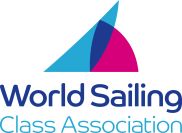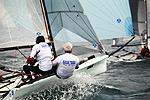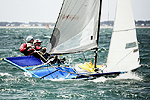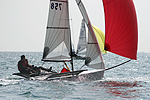In 1987 the B14 was launched in Australia. Since then fleets have also grown in Japan and Hong Kong. In 1993 Rondar Race boats Ltd launched the B14 into Europe. The world circuit rotates between the Northern and Southern hemispheres every one and a half years. The B14 first began its world journey in 1998 where the first world championships were held at Weymouth. Following this the next championships were held in Sydney in 2000 and then proceeding to Lake Garda, Italy in 2001.
McCrae, Victoria Australia was the next in 2003 when the first boats journeyed from Tasmania to join both the national and world championships. 2004 witnessed the world event return to Garda in Italy for the last time before returning to England in three years time.
Along came 2006 where Sydney again got to witness the presence of the B14 fleet at Woollahra Sailing Club. The UK claimed a full clean sweep of the podium with 1st to third place.
2007 saw the world championships return tothe united Kingdom with Restronguet Sailing Club in Falmouth, England playing host to the event in the UK's allegedly sunny South West. This was the first return to the UK since the first world championships in 1998. Great sailing and entertainment was had by all with the wind conditions being perfect for heavier crews. Crews were greeted by the rolling swells of the English Channel and on the last day of racing got to experience close proximity racing in the Carrick Roads waterway after conditions proved too rough to race in open water.
Tasmania hosted the next southern hemisphere World Championships in Hobart, Royal Yacht Club of Tasmania in 2009 and hosted the biggest ever fleet size at a world championships with a total of 52 entrants from across the globe. Up until this championship, the UK had dominated results boasting every world championship win. This year was the first for Ausutralia claiming the win and ashes.
in 2010 Carnac pllayed host to the world championships in France for the first time and was a very attractive proposition for the crews from the southern hemisphere. Once again Australia was able to hold international crews at bay to maintain the coveted world championship for another day.
2013 saw a return to Plerin in Frances northern coast, light conditions prevailed following a windy european championship and resulted in the UK claiming back the title for the ashes in a championship dominated by Australian and UK competitors.
In 2015 McCrae in the state of Victoria once again played host to the World Championships, 3 countries attended from the UK, France and Australia and the northern hemisphere crews were able to enjoy a fortnight of the Australlian summer and escape the freezing cold for a short break. Back on home soil the Aussie crews had got it together and claimed the victory back in a tight battle with some of their own, claiming a clean sweep of the podium. the first since sydney in 2006 when the UK did the same to the aussies.
2016 Lake Garda brought the biggest Australian fleet out of any northern hemisphere championship with 14 boats attending the championship from downunder. The UK had the upper hand with local knowledge of the conditions but three Aussie crews managed to get their heads around the game well enough to play havoc to the UK crews. The Aussies managed to keep well across the top three for sometime with one uk crew sneaking into second place in the final days racing.
The next world championships are scheduled for January 2018 and are being hosted by the Port Dalrymple Yacht Club at Beauty Point, Tasmania Australia. The water where the championships are being sailed is called Bell Bay and provides some great and consistent sea breezes throughout the year but in particular in the summer months. 35 crews are expected to attend the championships.
- Details
A scaled-down 18 foot skiff the B14 delivers exhilarating sailing, high quality international racing and as much fun as you can handle. It is the fastest two person ‘body-swung’ sailing boat in the world. Hiking from the wide wings, blasting along at 20 knots with over 50 sq.m. of downwind sail area is like nothing else in the world. It is a drug that attracts a growing number of addicts around the world.
As an ISAF Recognised Class, we hold World, European and National Championships at the best venues in Europe, and Australia. Our aim is to provide simple, one design, low-cost sailing for people who enjoy the adrenalin rush of sailing light-weight, high performance skiffs
- Details





